It was a ‘tug on your heartstrings’ kind of night at the London advisory committee on heritage meeting on Thursday.

75-year-old Londoner Nan Finlayson made another ‘impassioned plea’ to save the nearly 120-year-old heritage protected home where she’s lived at 100 Stanley St., near Wharncliffe and Horton, for decades.
The battle began earlier this year when it was learned the city was considering demolishing the home and expropriating Finlayson’s land to widen Wharncliffe Road at Horton Street.
Finlayson has fought to keep her home through media interviews, a petition and pleas to city hall.
Back in January the heritage committee gave its support to Finlayson, which isn’t binding, recommending against demolition.
“My physical, emotional and mental states of health depend on my remaining in my home and working in my garden. The home and garden feed my soul,” said Finlayson.
The committee heard how Finlayson has looked after her home, paying for a new roof, a new furnace, insulation and a chimney all while keeping the original windows, floors and key characteristics of the home.
The city wants to expand Wharncliffe Road at the Horton Street underpass from two lanes to four lanes, including two turn lanes. The city needs the land to build new abutments for the railroad bridge that covers the intersection.
City staff are recommending Finlayson’s home be moved to an empty plot of city-owned land 60m away on the west side of Wharncliffe Road South, south of Evergreen Ave, then turn the land into St. James Park, which is what the property used to be before the home was built in 1901.
Finlayson has remained steadfast she wants to remain where she is.
“The designated heritage home fits here, it’s in its proper place, it is at home,” she told the committee. “Home is the ultimate refuge, the destination of the spirit, and this is my home.”
The other options presented by city staff include leaving the home where it is and demolishing the house altogether.
Leaving the house as is would require removing Finlayson’s prized garden, sharing a driveway with the home at 98 Stanley St., and temporarily moving out of the house for 18-24 months while construction is underway.
Staff say demolishing the home is the most effective option.
City staff say they’re recommending the home be moved because it offers the best opportunity to protect the cultural heritage value and no other options to retain the house at its current location are considered viable given LACH doesn’t support demolition.
None of the options resonated with the heritage committee who questioned the need widen the road in the first place.
“There are a number of us who think the road widening is unnecessary. So the question isn’t, how do we widen the road without re-locating the house, the question is why are we widening the road to begin with,” said LACH member Ben Vazquez.
The road widening is part of London’s 2030 Transportation Master Plan. Staff say the city has been considering changing the intersection for the past 40 years.
The cost to heritage rankled committee members, who were told earlier this year 60 heritage properties were demolished when Horton Street was extended in the 1970s.
“We are building are city around the cars rather than making our cars work around the city,” said Vazquez.
Ultimately the committee passed a motion saying moving the house across the street is the possible but not preferred solution, but they do consider it better than demolition.
The issue now goes to a future civic works committee meeting.









Comments